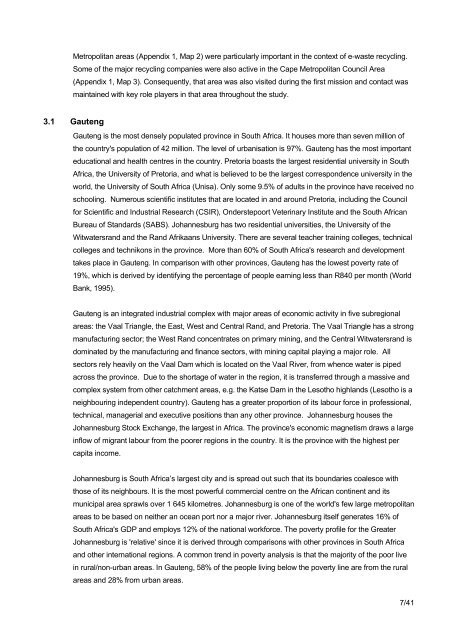E-WASTE ASSESSMENT IN SOUTH AFRICA - e-Waste. This guide
E-WASTE ASSESSMENT IN SOUTH AFRICA - e-Waste. This guide
E-WASTE ASSESSMENT IN SOUTH AFRICA - e-Waste. This guide
Create successful ePaper yourself
Turn your PDF publications into a flip-book with our unique Google optimized e-Paper software.
Metropolitan areas (Appendix 1, Map 2) were particularly important in the context of e-waste recycling.Some of the major recycling companies were also active in the Cape Metropolitan Council Area(Appendix 1, Map 3). Consequently, that area was also visited during the first mission and contact wasmaintained with key role players in that area throughout the study.3.1 GautengGauteng is the most densely populated province in South Africa. It houses more than seven million ofthe country's population of 42 million. The level of urbanisation is 97%. Gauteng has the most importanteducational and health centres in the country. Pretoria boasts the largest residential university in SouthAfrica, the University of Pretoria, and what is believed to be the largest correspondence university in theworld, the University of South Africa (Unisa). Only some 9.5% of adults in the province have received noschooling. Numerous scientific institutes that are located in and around Pretoria, including the Councilfor Scientific and Industrial Research (CSIR), Onderstepoort Veterinary Institute and the South AfricanBureau of Standards (SABS). Johannesburg has two residential universities, the University of theWitwatersrand and the Rand Afrikaans University. There are several teacher training colleges, technicalcolleges and technikons in the province. More than 60% of South Africa's research and developmenttakes place in Gauteng. In comparison with other provinces, Gauteng has the lowest poverty rate of19%, which is derived by identifying the percentage of people earning less than R840 per month (WorldBank, 1995).Gauteng is an integrated industrial complex with major areas of economic activity in five subregionalareas: the Vaal Triangle, the East, West and Central Rand, and Pretoria. The Vaal Triangle has a strongmanufacturing sector; the West Rand concentrates on primary mining, and the Central Witwatersrand isdominated by the manufacturing and finance sectors, with mining capital playing a major role. Allsectors rely heavily on the Vaal Dam which is located on the Vaal River, from whence water is pipedacross the province. Due to the shortage of water in the region, it is transferred through a massive andcomplex system from other catchment areas, e.g. the Katse Dam in the Lesotho highlands (Lesotho is aneighbouring independent country). Gauteng has a greater proportion of its labour force in professional,technical, managerial and executive positions than any other province. Johannesburg houses theJohannesburg Stock Exchange, the largest in Africa. The province's economic magnetism draws a largeinflow of migrant labour from the poorer regions in the country. It is the province with the highest percapita income.Johannesburg is South Africa’s largest city and is spread out such that its boundaries coalesce withthose of its neighbours. It is the most powerful commercial centre on the African continent and itsmunicipal area sprawls over 1 645 kilometres. Johannesburg is one of the world's few large metropolitanareas to be based on neither an ocean port nor a major river. Johannesburg itself generates 16% ofSouth Africa's GDP and employs 12% of the national workforce. The poverty profile for the GreaterJohannesburg is 'relative' since it is derived through comparisons with other provinces in South Africaand other international regions. A common trend in poverty analysis is that the majority of the poor livein rural/non-urban areas. In Gauteng, 58% of the people living below the poverty line are from the ruralareas and 28% from urban areas.7/41
















